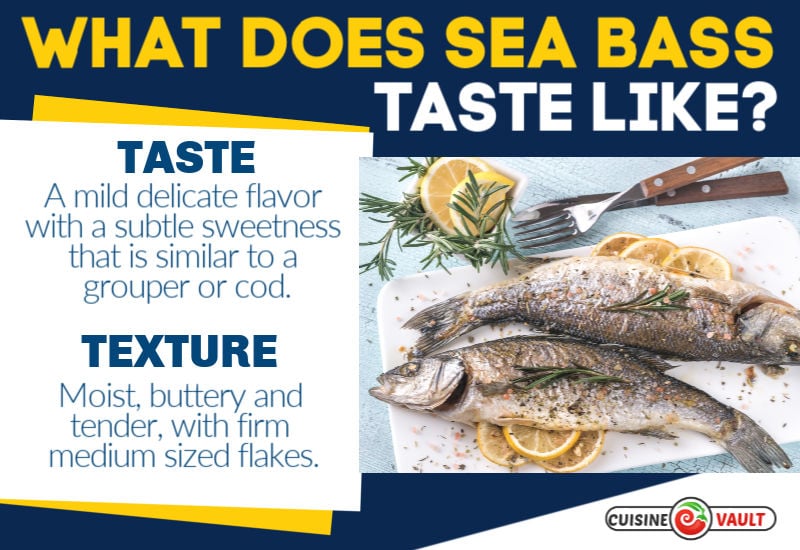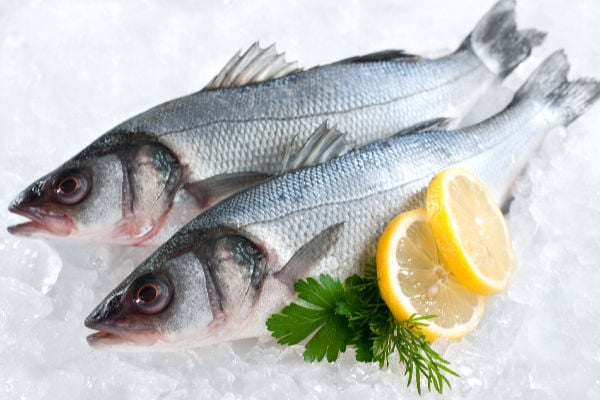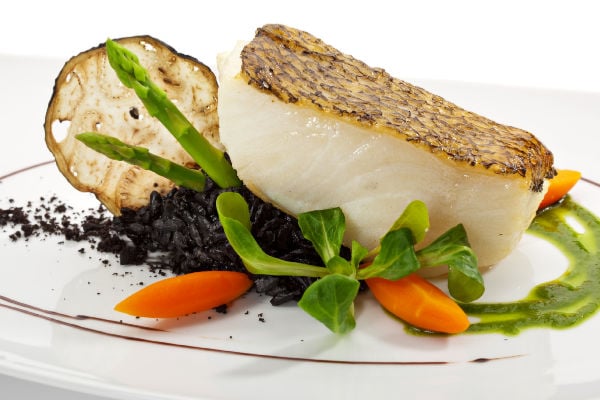The sea bass gained popularity on restaurant menus in the 1990s. This was partly due to its cheap price, but the main reason was a name change, from Patagonian toothfish to sea bass. Since then, its fish levels have reduced significantly and prices have increased. However, this fish is still available in the United States, more commonly in restaurants.
Would you like to know what sea bass tastes like? In this article, we’ll describe this fish's flavor, texture, and much more. Before we start, it’s important to point out that sea bass is a generic term that includes a range of different fish varieties. Some of them aren’t even sea bass. They all share similar characteristics, but we’ll provide details of some of the best-known types and their flavors below. Let’s get started.
How does sea bass taste?
Sea bass is a white fish that has a mild delicate flavor with a subtle sweetness that is similar to grouper or cod. The flesh is moist, buttery, and tender, with firm medium-sized flakes like haddock. Sea bass is an excellent choice for people with a sensitive palate that don’t enjoy “fishy tasting” seafood. On a flavor scale, this fish would be placed at the opposite end from anchovies or sardines.
Flavor profile summary
| Feature | Description |
|---|---|
| Flavor | Mild, delicate, sweet |
| Texture | Moist, buttery, meaty, firm |
| Flakes | Medium sized |
| Oiliness | Lean |
| Color (cooked) | White |
 Fish flavor guides:
Fish flavor guides:
We’ve created in-depth guides on a range of popular fish types. Read all about some of the great ocean fish like walleye, red snapper, mahi mahi, flounder, and salmon.
5 types of sea bass
The flavor and texture will vary depending on the type of sea bass you eat. Below are some of the best-known options from different parts of the world.
1. Black Sea Bass
For those in the United States that love recreational fishing, this is the fish you want to be hooked on the end of the line. It is found on the Atlantic Coast and is a small fish with white, firm flesh and delicate flavor. The texture of black sea bass fillets has unique small flakes; its lean flesh makes it prone to overcooking, resulting in a dry fish. When cooked well, it is delicious seafood, with great balance of flavor. It is sought after by sports fishermen.
Other names: Chub, tallywag, black bass, black perch.
2. Chilean sea bass
If you’re eating sea bass at a restaurant then this variety could be what you’re eating, which comes from the Antarctic or South America. We always recommend checking that the fish has been caught sustainably as there are strict quotas on this variety, due to overfishing. This variety is richer than the black sea bass and is much more forgiving when overcooked. This is thanks to its high-fat content, which has developed from living in the icy waters of the Southern Ocean.
3. European Sea Bass
The European sea bass is found in the warmer waters of the Black Sea and Mediterranean. This fish has a mild, sweet flavor and fine-textured flaky meat. The species are farmed, but if you can get hold freshly caught wild sea bass, it will have a better flavor.
4. Giant sea bass
This type of bass is actually a grouper. You can find out more about grouper here. It has a widespread habitat, living on both sides of the Pacific; the Northern Channel Islands is a popular place to find them. This variety has large meaty flakes that is a little more fishy than its smaller cousins.
5. Hapu
This is another grouper that can only be found in the Hawaiian Islands. It is a good eating fish that is similar to Hawaiian Snapper, with a delicate taste and white flaky meat.
How to select the freshest fish
Although sea bass isn’t widely available at stores like some other fish varieties, you may find it at a local fish market or specialty fishmonger. To get the freshest fish, check that the eyes look fresh and bright with no glazing. If possible, give the eye a quick poke to ensure that is bounces back.

Look for bright, cloud-free eyes in fresh fish.
The fish shouldn’t have a powerful fishy aroma so avoid the fish if it does. Buying frozen sea bass is a handy option as they haven’t had the chance to go bad. You can often find bags of frozen fish at large stores like Costco or online.
If you get the opportunity to go sea bass fishing then you’ll have a chance to catch the freshest fish possible, so we recommend doing it!
How to cook sea bass
Sea bass will have a lovely moist, flaky texture when cooked well. Pan-seared in olive oil or butter with salt and pepper is a quick and easy option. Cook each side for only 3-4 minutes on medium heat for best results.
Sea bass can also be baked, roasted, grilled, steamed, or poached. We recommend leaving the fish out of the refrigerator for 20 minutes before cooking to stop the fish from overcooking on the outside while remaining undercooked inside. An easier was to consistently cook tender fish is to use a specialized cooker. We reviewed the top fish roasters currently available and recommend checking it out for anyone that's serious about their fish.
Flavors that compliment sea bass
Seasoning: dill, oregano, thyme, parsley, garlic, salt and pepper, lemon.
Side dishes: rice, potatoes, quinoa, steamed vegetables, couscous.
Wine: Sake, a crisp sauvignon blanc, or a dry rosé.

Sea bass is a versatile fish in the kitchen.
Nutritional Information
The sea bass is an excellent source of Omega-3, protein, and vitamin B12. It is also low in fat and has no sugar or carbohydrates. Source.
Nutrition information for one fillet of sea bass.
| Calories | 125 |
| Total fat | 2.6g |
| Saturated fat | 0.7g |
| Carbohydrates | 0g |
| Sugar | 0g |
| Protein | 23.8g |
Did you know? There are many varieties of sea bass including white sea bass, Chilean sea bass, Blue spotted sea bass, Black Sea bass, Peruvian sea bass, and many more.
Interesting reading:
What does barracuda taste like?
What are the best monkfish substitutes?
Final words
The sea bass has been a popular fish on menus throughout the United States since the 90s. Unfortunately, due to overfishing, it is a much less common and more expensive menu item. If you get the chance to try it, you should give it a go. It is a mild, slightly sweet white fish that flakes apart deliciously. This is not an offensive, pungent type of seafood; instead, it is likely to appeal to most people, including children and fussy eaters.
If you decide to cook it at home, then the cooking method will play a big part in how the final dish turns out. We recommend pan-frying or baking as our preferred options. To get the best of both worlds you could sear the fish briefly, then bake it for the perfect fish. Just watch the cooking time and check regularly to make sure it doesn’t dry out.
Do you want to learn more about fish? Check out all our articles about fish to become a seafood guru.
What is your favorite type of fish that you couldn’t live without? Please let us know in the comments below.

Maricar
Thank you I learn about sea bass coz I'm reviewing our exam for sea bass dish on menu thank you for some idea from you sir.